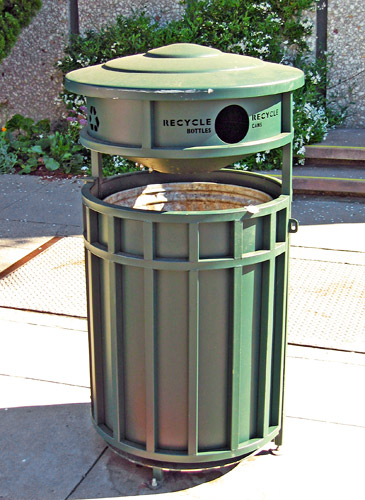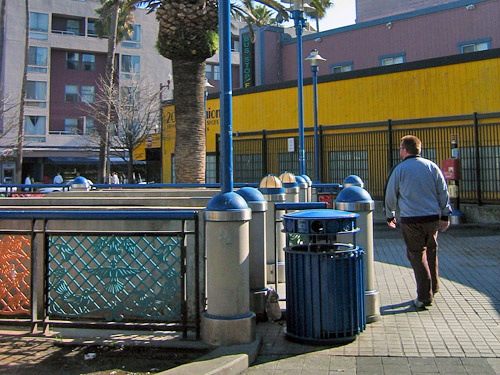See also Street Furniture Overview
Sidewalk trash cans and recycle bins are essential to the health and function of the city. Their presence along streets with high pedestrian discourages littering, resulting in a healthier more aesthetically pleasant environment. While trashcans are utilitarian, functional objects, they need not be utilitarian in their design. Attention to the design, materials and placement of trashcans enhances the public realm and adds to a sense of place.
Process Overview
Standard city sidewalk trash cans are typically installed and maintained by the Department of Public Works. To report a maintenance issue with a public trash can, call or go to 311.
Decorative trash cans may also be installed by community groups such as neighborhood or merchant’s associations, or as part of a larger package of corridor-wide improvements.
Trash cans as part of a corridor-wide design typically require a Minor Sidewalk Encroachment Permit from DPW.
If your project involves multiple streetscape elements, you must obtain relevant permits for all features. For projects involving various streetscape elements, DPW will often streamline the process by combining multiple elements under one or more permits.
See Permit Process for more information
Official Codes & Documents
- Better Streets Plan (street design guidelines)
Design Guidelines
Street types: Downtown Commercial, Commercial Throughway, Neighborhood Commercial, Downtown Residential, Residential Throughway, Neighborhood Residential, Industrial, Mixed Use, Parkway, Park Edge, Multi-Way Boulevard, Ceremonial, Alley, Shared Public Way, Paseo
Sidewalk zones: Extension Zone, Furnishing Zone
Location of trash receptacles
Trash receptacles should be located near as near to corners as is practicable but out of the corner clear zone.
They should be located near high activity generators such as major civic and commercial and transit destinations.
There should be a maximum of one trash receptacle every 200 feet along commercial streets. Additional trash receptacles should be provided only if a private sponsor provides continued maintenance.
A maximum of four trash receptacles should be provided at an intersection (one per corner).
Design of trash receptacles
When selecting trash receptacles, they should be considered as a design element, and design should reflect aesthetic as well as functional concerns.
Trash receptacles should be selected from the same or a similar design “family” as other site furnishings (such as benches, bollards, bike racks, etc.) and should be finished or painted to complement other site furnishings.
Trash receptacle construction should use durable, high quality materials, such as galvanized or stainless steel.
Materials should be painted to reflect colors similar to nearby elements. Material and paint selection should be graffiti resistant.
Trash receptacles should include recycling containers and should be able to open from the side to allow easy access for removal of garbage bags.
Maintenance
With some exceptions, fronting property owners are responsible for the on-going maintenance and upkeep of sidewalk paving as well as all sidewalk elements directly fronting their property, such as trees, landscaping, and streetscape furnishings. Generally, the City is responsible for maintaining roadway paving and other features in the roadway, such as medians.
Standard city sidewalk trash cans are typically maintained by the Department of Public Works. To report a maintenance issue with a public trash can, contact 311.
If you obtain a permit to install a sidewalk trash can, you will be responsible for its maintenance. Specific requirements will be described in your permit.
For a more detailed description of maintenance responsibilities, see Maintenance.








 Copyright © 2015
Copyright © 2015